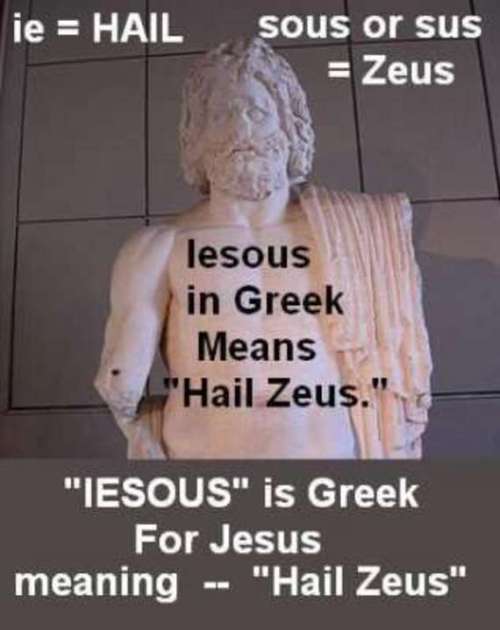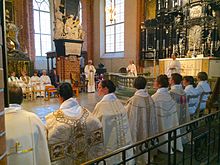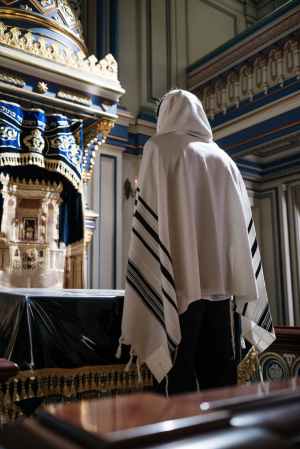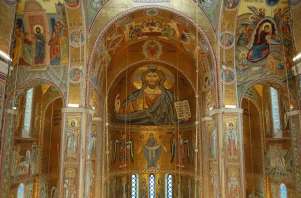Looking for the church
Someone has said,
“I looked for the Church, and found it in the world. I look for the world, and found it in the Church.”
The word ICHABOD has been stamped on many a local church door, but only spiritual eyes can see that the glory of the Lord has departed. {It is Easier to Change the Local Church than the Bible}
That is the problem of our world or the problem of our nation … human beings always looking for other human beings and believing in human beings more than in the Word of the Highest all-knowing eternal God above all gods.
Coming face to face with God
Mankind is afraid to come face to face with God. It is impossible for man to see God, though man wants to have something they can refer to, see and feel or touch. They also want to have a god who has similarities with them, and therefore they took themselves a godhead they can grab. Of that god they created for themselves, a male figure, they can take pictures and statues. Even when the Bible tells mankind that he may not make any graven image of God, man prefers to ignore such demands and has made himself many images of their god.

The Holy Scriptures or Infallible Word of God – Photo by cottonbro on Pexels.com
Too many people do forget or do not want to see that God promises to work through His Word and that This Word of God gives all the knowledge that we need to come to find God and to come to know what God wants from us. God wants to have a relationship with His creatures. He did not create them to be against Him, in the same way, He did not give them commandments of which He knew man would be able not to keep them.
Sinful people
By the first sinful act of Adam and Eve, sin came into the world. All those coming after them were sinful people. Still today it is like that. It would be very difficult to find someone who is without something doing wrong or without having sinned. We are all taken up by sin.
“As by means of one man, sin entered into the world, and, by means of sin, death; and so death passed upon all the sons of men, inasmuch as they all have sinned: — ” (Ro 5:12 Murdock)
“If thou doest well, shalt thou not be accepted? And if thou doest not well, sin lieth at the door. And unto thee shall be his desire, and thou shalt rule over him.”” (Ge 4:7 KJ21)
“”If they sin against Thee (for there is no man that sinneth not), and Thou be angry with them and deliver them to the enemy so that they carry them away captives unto the land of the enemy, far or near;” (1Ki 8:46 KJ21)
It is that sinning that is standing in the way to have a good relationship with our heavenly Father. To come to a better relationship God provided means. One of those was by creating a possibility for man to show his submission to God and his desire to please God by offering sacrifices to God. Later in the history of mankind, there came special places to bring such offerings to God and as such temples came into existence, where also special people took care of the services for God. Those priests were at first anointed by God Himself, though later man took care of themselves to appoint priests and to decide for themselves how those services to God and sacrifices were to be carried out. In a way such services would later become churchservices.
Houses of worship for the Only One God Jehovah
At first Jesus and his apostles went to those houses of worship. In those temples, they praised not Jesus but the God of the Hebrews, the God of Adam and Eve, the God of Abraham, Isaac and Jacob, Who is the Only True God. Jesus and his apostle were very well aware of that Name of That God. They worshipped Jehovah as the Only One True God.
“that men may know that Thou, whose name alone is JEHOVAH, art the Most High over all the earth.” (Ps 83:18 KJ21)
“2 And God spoke unto Moses and said unto him, “I am the LORD. 3 And I appeared unto Abraham, unto Isaac, and unto Jacob by the name of God Almighty, but by My name JEHOVAH was I not known to them.” (Ex 6:2-3 KJ21)
When Jesus was gone the apostle did not change their mind about Whom they had to worship and about Whom they had to pray to and call His Name.
“For “whosoever shall call upon the name of the Lord shall be saved.”” (Ro 10:13 KJ21)
“and in that day shall ye say: “Praise the LORD! Call upon His name! Declare His doings among the people; make mention that His name is exalted.” (Isa 12:4 KJ21)
The way of worshipping did not change in the first century. It was customary for them to continue to go to the temple and to praise and glorify God there, as well as to continue to study the Hebrew Scriptures. They were convinced that such worship of God should come from deep within the heart and not be a mere passing fancy.
“God is a Spirit, and they that worship Him must worship Him in spirit and in truth.”” (Joh 4:24 KJ21)
“yet to us there is but one God, the Father, from whom are all things and we in Him, and one Lord Jesus Christ by whom are all things, and we by Him.” (1Co 8:6 KJ21)
Yes, not Jesus was their god, but the Divine Creator of heaven and earth was their God. To them, it was as pure as a lump of sugar or clear as water, that this God is only one.
“”Hear, O Israel: The LORD our God is one LORD.” (De 6:4 KJ21)
One God and His beloved son opposite a god the son
They felt that they had become one in God by the sent one from God in whom they came to believe as that promised one from old times, who they now recognised as their saviour or that promised Messiah, by whom they now got the opportunity to get a new life.
“yet to us there is but one God, the Father, from whom are all things and we in Him, and one Lord Jesus Christ by whom are all things, and we by Him.” (1Co 8:6 KJ21)
It was several years after Jesus had died that certain people started taking Jesus as their god, forgetting the words Jesus himself had spoken.
“Jesus said unto her, “Touch Me not, for I am not yet ascended to My Father; but go to My brethren and say unto them, ‘I ascend unto My Father and your Father, and to My God and your God.’”” (Joh 20:17 KJ21)
Today there are still many people who do not hear or want to understand those words of that son of man, who gave his life for many, so that we can have hope for receiving a new life in the Kingdom of God.
“Blessed be the God and Father of our Lord Jesus Christ, who according to His abundant mercy hath begotten us again unto a living hope by the resurrection of Jesus Christ from the dead,” (1Pe 1:3 KJ21)
Those who claim that Jesus is God, should better think about the fact that Jesus more than once prayed to Whom he called God. He did not pray to himself, neither cried to himself, or did not ask himself why He had abandoned him. (How would a person abandon or forsake himself?)
“And at the ninth hour Jesus cried out with a loud voice, saying, “Eloi, Eloi, lama sabachthani?” which is, being interpreted, “My God, My God, why hast Thou forsaken Me?”” (Mr 15:34 KJ21)
“1 These words spoke Jesus and lifted up His eyes to Heaven and said, “Father, the hour is come. Glorify Thy Son, that Thy Son also may glorify Thee, 2 as Thou hast given Him power over all flesh, that He should give eternal life to as many as Thou hast given Him. 3 And this is life eternal: that they might know Thee, the only true God, and Jesus Christ whom Thou hast sent.” (Joh 17:1-3 KJ21)
The apostle Peter might be one of the first apostles who publicly professed who Jesus Christ was.
“16 And Simon Peter answered and said,
“Thou art the Christ, the Son of the living God.”
17 And Jesus answered and said unto him,
“Blessed art thou, Simon Bar-Jonah, for flesh and blood hath not revealed it unto thee, but My Father who is in Heaven.” (Mt 16:16-17 KJ21)
A son of man as a way to God
It was such confession that the apostles required also from those who wanted to go in the footsteps of their master teacher. This way started of a group of followers of Christ. People who were convinced that Jesus was the way, like he more than once told others.
“Jesus said to him: I am the way, and truth, and life: no one cometh unto my Father, but by me.” (Joh 14:6 Murdock)
“Whosoever shall confess that Jesus is the Son of God, God dwelleth in him, and he in God.” (1Jo 4:15 KJ21)
The apostles also wrote down how they came to understand who Jesus Christ was and how the world had come to see that he is the son of man and son of God. By writing it all down, those writings should give a clear picture of Whom God is and about whom Jesus is.
“And the angel answered and said unto her,
“The Holy Spirit shall come upon thee, and the power of the Highest shall overshadow thee. Therefore also that Holy Being who shall be born of thee shall be called the Son of God.” (Lu 1:35 KJ21)
“And I saw and bore record that this is the Son of God.”” (Joh 1:34 KJ21)
“29 Jesus said unto him,
“Thomas, because thou hast seen Me, thou hast believed. Blessed are they that have not seen and yet have believed.”
30 And many other signs truly did Jesus in the presence of His disciples, which are not written in this book. 31 But these are written, that ye might believe that Jesus is the Christ, the Son of God, and that believing, ye might have life through His name.” (Joh 20:29-31 KJ21)
Accepting Jesus as son of God
That life which may come over us is by accepting who Jesus is, the son of God, and not by going all the fancies of the world. It are not the human doctrines we should take for the rules to follow, but the Biblical doctrines we should take for granted and to go by. It are those sacred writings that tell us that Jesus is now sitting at the right hand of God, being a mediator between God and us.
“5 For there is one God and one mediator between God and men, the man Christ Jesus, 6 who gave Himself a ransom for all, to be testified in due time,” (1Ti 2:5-6 KJ21)
For those who continued to follow the apostles of Jesus it is clear that there is one God, the Father, from whom are all things, and that newt to This God there is the one Who God Himself declared to be His only beloved son, Jesus Christ the Messiah. (1Co 8:6)
Followers of false teachings and false teachers
Up to today there are people who want to follow the teachings of those false teachers who claimed that Jesus would be an incarnated God. Some of the present teachers or pastors even want to twist the historical truth and come to say that it were the non-trinitarian preachers who would have followed Greco-Roman philosophy, though it are the Trinitarians who took all sorts of believes of those philosophers in their teaching, like incarnation, separate souls who would leave the body after death, hell as a burning place of eternal torture, etc. . Instead of bringing people on the right path to God, they mislead their churchgoers and having them worship a false god.
Already in the first century, the apostles warned against such false teachers who violated the Word of God and often came to deceive people with things they liked to hear. Such a God made flesh appealed to many, and still does. Hereby lots of people forget how often in the Bible is told that Jesus is the son of God (something totally different as “god the son”) and how Jesus himself spoke about his heavenly Father, from Whom he came and to Whom he went again.
“Jesus said to her:
Touch me not; for not yet have I ascended to my Father. But go to my brethren, and say to them: I ascend to my Father and your Father, and to my God and your God.” (Joh 20:17 Murdock)
Those teachers claiming that Jesus would be God destroy the value of Jesus’ act of sacrifice and make God a great comedian who repeatedly told lies to deceive people, let alone called Himself a “God of no lies” when He did see mankind as lying creatures. Those Trinitarian preachers seem to neglect that The God of no lies said Himself that Jesus is His beloved son.
“And lo, a voice came from Heaven, saying,
“THIS IS MY BELOVED SON, IN WHOM I AM WELL PLEASED.”” (Mt 3:17 KJ21)
“God forbid! Yea, let God be true, though every man a liar. As it is written:
“That Thou mightest be justified in Thy sayings, and mightest overcome when Thou art judged.”” (Ro 3:4 KJ21)
Not only minimalise those preachers the self-sacrifice of Jesus the also make the resurrection of Jesus as a joke, because God can not die (Him being an eternal Spirit) and when Jesus is God we are still left with no proof at all that man would be able to step out of the dead. As such those trinitarian churches take away our hope for a resurrection, because we can not become God and do like Him, but are then still bounded to the grave (sheol or hell). The real followers of Christ continued teaching the Gospel or Good News of the coming Kingdom of God, by which there is the hope in the resurrection of the man Jesus Christ, as an example of what can happen to us.
“Blessed be God, the Father of our Lord Jesus the Messiah, who in his great mercy hath begotten us anew, by the resurrection of our Lord Jesus the Messiah, to the hope of life,” (1Pe 1:3 Murdock)
Not a schizophrenic God
Jesus was or is not a schizophrenic God Who came to pray and cry to himself. Jesus prayed sincerely to his heavenly Father, Whom he considered to be the Only One True God.
“And at the ninth hour, Jesus cried with a loud voice, and said: [Il, Il, lemono shebakthone;]that is: My God, my God; why hast thou forsaken me?” (Mr 15:34 Murdock)
“1 These things spake Jesus, and lifted up his eyes to heaven, and said: My Father, the hour is come: glorify thy Son, that thy Son may glorify thee. 2 As thou hast given him authority over all flesh, that he might give life eternal to as many as thou hast given him. 3 And this is life eternal, that they may know thee, that thou art the only true God, and whom thou hast sent, Jesus Messiah.” (Joh 17:1-3 Murdock)
It might have taken some time before the apostles really came to see who their master-teacher really was and how they should behave and go into the world as his disciples and workers for God. It can well be that the apostle Peter was the first one to recognise for the first time in public Jesus real position.
“16 Simon Cephas {Greek: Simon Peter} answered and said:
Thou art the Messiah, the Son of the living God.
17 Jesus answered, and said to him:
Blessed art thou, Simon son of Jonas; for flesh and blood have not revealed [it] to thee, but my Father who is in heaven.” (Mt 16:16-17 Murdock)
The religion of Old Testament not passing away
After that Jesus was taken into heaven by his heavenly Father and after Jesus promised helper came over the apostles they dared to come out in public again and started off their great preaching work.
Those who heard and/or saw Jesus preach and/or heard the apostles, could not believe that the religion of the Old Testament, revealed by God Himself, should pass away. They indeed regarded Jesus as the Saviour of Gentiles as well as Jews. We could say that Judaism was for them considered the necessary introduction to their group (which we call today Christianity). Several people from all sorts of rang came to join the apostles. Their Jewish movement was called “The Way“.
But by joining more non-Jews the matter of circumcision and the observance of the whole Mosaic law came under discussion. The question was the sole condition of an interest in the Messianic salvation. And, offensive as Judaism was, rather than attractive, to the heathen, this principle would have utterly precluded the conversion of the mass of the Gentile world. The apostles themselves were at first trammelled by this Judaistic prejudice, till taught better by the special revelation to Peter before the conversion of Cornelius.
But even after the baptism of the uncircumcised centurion, and Peter’s defence of it before the church of Jerusalem, the old leaven still wrought in some Jewish Christians who had formerly belonged to the rigid and exclusive sect of the Pharisees, to which the apostle Paul also belonged to.
Difficulties around gentile converts
The churches of Jerusalem and Antioch resolved to hold a private and a public conference at Jerusalem. Antioch sent Paul and Barnabas as commissioners to represent the Gentile converts. Paul, fully aware of the gravity of the crisis, obeyed at the same time an inner and higher impulse. He also took with him Titus, a native Greek, as a living specimen of what the Spirit of God could accomplish without circumcision. The conference was held C.E. 50 or 51 (fourteen years after Paul’s conversion). It was the first and in some respects the most important council or synod held in the history of Christendom, though differing widely from the councils of later times. It is placed in the middle of the book of Acts as the connecting link between the two sections of the apostolic church and the two epochs of its missionary history.
In the beginning, the people from The Way, like all the Jews, went on the Sabbath to the gathering in the temple. But after more goyim or non-Jews had joined that movement which confessed that Jesus is the son of God (Lu 1:35 ), and as such also came to abide in God (1Jo 4:15), they were not so welcome anymore in the temples and synagogues. Those non-Jews by their baptism in Christ being taken up in the group, which grew fairly quickly, and made others look jealous at them but also did not want those non-Jews in their prayer houses. Therefore The Way started also to come together in private houses and as such creating the first house churches.
Seeing and not seeing the man of flesh and blood
The apostles had after some years got a very clear picture of Jesus and with them many others had seen this man of flesh and blood (remember that God can not be seen by man). They testified that their master is the Son of God (Joh 1:34) and never said that Jesus would have claimed such a position, to be God. The amount of false teachers grew and began to argue with the true followers of Jesus who held to the sonship of Christ Jesus and did not wish to enter into the false teaching of Jesus’ Godhead.
In ancient time people could see and hear Jesus. We do not have such an opportunity anymore, though we should go by the material which is handed over to us in the Books of the New Testament. They provide enough information to learn about the man Jesus from Nazareth and his disciples. In connection with the Books of the Old Testament one should clearly come to see what Jesus role is in the history of mankind. Not having seen Jesus Christ, there were loads of people who came to believe in the son of God, that man of flesh and blood. Not having been able to see Christ we have to believe in him and accept him as the mediator for us by his heavenly Father the Only One True God.
“29 Jesus said to him: Now, when thou hast seen me, thou believest: blessed are they, who have not seen me, yet believe. — 30 And many other signs did Jesus before his disciples, which are not written in this book. 31 But these are written, that ye may believe that Jesus is the Messiah, the Son of God; and that when ye believe, ye may have life eternal by his name.” (Joh 20:29-31 Murdock)
“5 For God is one; and the mediator between God and men is one, [namely] the man Jesus the Messiah; 6 who gave himself a ransom for every man; — testimony that arrived in due time,” (1Ti 2:5-6 Murdock)
Jerusalem consultation
The object of the Jerusalem consultation was twofold: first, to settle the personal relation between the Jewish and Gentile apostles, disciples and preachers, and to divide their field of labour; secondly, to decide the question of circumcision, and to define the relation between the Jewish and Gentile Christians. On the first point (as we learn from Paul) it effected a complete and final, on the second point (as we learn from Luke) a partial and temporary settlement. In the nature of the case the public conference in which the whole church took part, was preceded and accompanied by private consultations of the apostles.
Constantine period
In the fourth century the division between the real followers of Christ and the followers of those false teachers who mixed those teachings of Christ with other human teachings, had become so big that they called for a council to decide how the church would continue.
Constantine I (the Great) the founder of Constantinople and the Byzantine empire, and for someone of the most gifted, energetic, and successful of the Roman emperors, was the first representative of the imposing idea of a Christian theocracy, or of that system of policy which assumes all subjects to be Christians, connects civil and religious rights, and regards church and state as the two arms of one and the same divine government on earth. This idea was more fully developed by his successors, it animated the whole middle age, and is yet working under various forms in these latest times; though it has never been fully realised, whether in the Byzantine, the German, or the Russian empire, the Roman church-state, the Calvinistic republic of Geneva, or the early Puritanic colonies of New England. At the same time, however, Constantine stands also as the type of undiscriminating and harmful conjunction of Christianity with politics, of the holy symbol of peace with the horrors of war, of the spiritual interests of the kingdom of heaven with the earthly interests of the state.
He was the man who gave those preachers the choice to come with the world or to stay by their ideas of not being part of the world. The majority choose to be befriended and to walk in fellowship with the world.
Unquestionably every age produces and shapes its own organs, as its own purposes require and as such the Jewish movement of The Way had seen many people going astray and going their own way. Constantine I did put himself at the head of the age, and was annoyed by the differences and discussions there were by those who claimed to be the followers of the Nazarene rebbe Jeshua ben Josef, Jesus Christ. He also clearly saw that idolatry had outlived itself in the Roman empire, and that Christianity alone could breathe new vigour into it and furnish its moral support.
Donatists and Arians
From the year 313 he placed himself in close connection with the ‘bishops’, made peace and harmony his first object in the Donatist and Arian controversies and applied the predicate “catholic” to the church in all official documents. The Donatists argueing that Christian clergy must be faultless for their ministry to be effective and their prayers and sacraments to be valid. Constantine, hoping to defuse the unrest, gave money to the non-Donatist bishop Caecilian as payment for churches damaged or confiscated during the persecution. Nothing was given to the Donatists; Constantine was apparently not fully aware of the seriousness of the dispute, which his gift exacerbated. The Donatists appealed to Rome for equal treatment; Constantine tasked Miltiades with resolving the issue, which led to the 313 commission.
Many non-trinitarians are often called Arians by Trinitarians, though often those Christians do not follow Arius his teachings but simply the Biblical teachings. The Christian priest Arius, whose teachings gave rise to a theological doctrine known as Arianism, also followed the apostolic teaching that God is One and that Jesus is His son and not God Himself. What makes Arainism so different with what many non-trinitarians are still following today, is that those real followers of Christ (including us) do not integrate Neoplatonism, nor are we inspired by Plato’s ideas or by pre-Socratics (who interpreted the world monistically in terms of nature as such), from the relativism of the Sophists, and from the correction of Platonism in a this-worldly direction carried out by Plato’s greatest pupil, Aristotle.
It is a very big misconception of Trinitarians that nonTrinitarians, or those who do not wish to accept Jesus as God, would be Arians, whereas they do not follow the teachings of Arius at all. The teaching those present non-Trinitarians follow is simply the teachings of Jesus and his apostles.
The only similarity in Arius and the present non-trinitarian denominations is Arius’s basic premise of the uniqueness of God, who is alone self-existent (not dependent for its existence on anything else) and immutable; the Son, who is not self-existent, cannot therefore be the self-existent and immutable God.
“”There is none like unto the God of Jeshurun [a poetic name for the people of Israel, meaning ‘upright people’], who rideth upon the heaven to thy help and in His excellency on the sky.” (De 33:26 KJ21)
“33 O the depth of the riches both of the wisdom and knowledge of God! How unsearchable are His judgments, and His ways past finding out! 34 “For who hath known the mind of the Lord? Or who hath been His counselor?” 35 Or, “who hath first given to Him, and it shall be recompensed unto him again?” 36 For of Him, and through Him, and to Him, are all things, to whom be glory for ever. Amen.” (Ro 11:33-36 KJ21)
Because the Godhead is unique, it cannot be shared or communicated according to Arius. Because the Godhead is immutable, the Son, who is mutable, must, therefore, be deemed a creature who has been called into existence out of nothing and has had a beginning. Moreover, according to Arius the Son can have no direct knowledge of the Father, since the Son is finite and of a different order of existence. For the real followers of Christ there is the knowledge that Jesus was placed in the womb of that young girl and as such coming directly from God must have some DNA from God. Jesus was born in that very devout Essene family of the tribe of King David and had got a very thorough religious upbringing with the Word of God as an inspirational source.
Name change
 Badly enough, most of the clergy wanted to come to an agreement with Constantine the Great in order to keep the peace and not to be persecuted anymore. This was done by the clergy to bring their religion more in line with the Greek Roman religion and their triple deity Zeus who was then the main deity worshipped by Constantine and his followers. In order to equate Jeshua (Yeshua) with that deity Zeus, his name was transformed from Jeshua to Issou or Yai_Zeus > Je-Zeus which means Hail Zeus. Since then, the false name (Jezus – Jesus – Chesu) has become fully accepted and in time it was also used by the non-trinitarians to make clear that they were talking about one and the same person as the Trinitarians.
Badly enough, most of the clergy wanted to come to an agreement with Constantine the Great in order to keep the peace and not to be persecuted anymore. This was done by the clergy to bring their religion more in line with the Greek Roman religion and their triple deity Zeus who was then the main deity worshipped by Constantine and his followers. In order to equate Jeshua (Yeshua) with that deity Zeus, his name was transformed from Jeshua to Issou or Yai_Zeus > Je-Zeus which means Hail Zeus. Since then, the false name (Jezus – Jesus – Chesu) has become fully accepted and in time it was also used by the non-trinitarians to make clear that they were talking about one and the same person as the Trinitarians.
Constantine was praised and censured in turn by the Christians and Pagans, the Orthodox and the Arians, as they successively experienced his favour or dislike, but the real followers of Christ saw in him a very dangerous despot who could easily subdue the false teachers and in unity oppose the true followers of Christ.
The ones coming under agreement with each other about the deity of Jesus and the wishes of Constantine, became the Roman Catholics, who claimed to be the only true church and continued to grow by making sure people from all sorts of tribes could find themselves at home, because many of their traditions were taken in or integrated into that religion.
The real followers of Christ Jesus did not like the name change but had to do with it. for many centuries they tried those who worshipped Jesus as their god to come to know the real Jesus from the Bible.
The groups which accented the absolute oneness of the Divinity as the highest perfection, with a literal, rationalist approach to the New Testament texts sought their way in the world. That point of view was publicized about 323 through the poetic verse of his major work, Thalia (“Banquet”), and was widely spread by popular songs written for labourers and travellers.
The non-Trinitarian aspect and the other Arian teachings (of Arius) and papal positions (Ursinus) brought forth further disputes and conferences, synods or councils. The Ursinians became established in Milan and rekindled their opposition to Damasus.
 Damasus I presided over the Council of Rome of 382 that determined the canon or official list of sacred scripture. He encouraged the production of the Latin Vulgate Bible with his support for Jerome.
Damasus I presided over the Council of Rome of 382 that determined the canon or official list of sacred scripture. He encouraged the production of the Latin Vulgate Bible with his support for Jerome.
He spoke out against other groups of Christians that had grown in popularity and denounced several major heresies in the church (including Apollinarianism and Macedonianism). In two synods (368 and 369) the unorthodox teachings of Bishop Macedonius of Constantinople and of Bishop Apollinaris (the Younger) of Laodicea were condemned. Among Damasus’s literary remains are 24 anathemas against various 4th-century heresies. Apollinaris The Younger and his father (Apollinaris the Elder) had reproduced the Old Testament in the form of Homeric and Pindaric poetry and the New Testament in the style of Platonic dialogues after the Roman emperor Julian had forbidden Christians to teach the classics.
Apollinaris the younger denied the existence in Christ of a rational human soul, a position he took to combat Arianism. Skilled in logic and Hebrew and a teacher of rhetoric, Apollinaris also lectured at Antioch c. 374. Their different ideas also brought forth several schisms.
Current Churches in a Torn Church World
It would not remain at all with these few schisms in the church community; in each century several schisms occurred. Today, many even regard certain breakaway groups as churches of the commons, such as the Lutheran, Calvinist and Anglican Churches. They now belong to the generally accepted Protestant churches.
Lots of churches sought ways to get as many followers as they could, claiming that they are the only church by which people can be saved. They forget that it are no other human beings, than Christ Jesus who saves people of all races and people of all persuasions or from all walks of life. They claimed and still claim that their sacraments, religious signs or symbols, are the way to be saved. Many of those churches are convinced that their liturgy is the best one to prepare people to receive those sacraments, as visible symbols of the reality of God, as well as a channel for God’s grace and helps to understand what they are doing. Their liturgy is used to give the sacraments context and is there to allow folks to see them in action. Outside of the liturgy, the sacraments lose direction and application. For some that is the reason why a private baptism or communion is a sacrament without purpose or meaning.
It is a sacrament that is cut off from its intended goal. {The Role of the Church}
For non-Trinitarians, like the Christadelphians, there does not have to be a set of liturgical rules and order. Each church service can be done in a different order or different way. but what is most important is that the service is built upon the Word of God, and as such most time of the service should be spent on that Word, or readings from the Holy Scriptures and not on readings from human beings. Next to that Word of God people should be able to find, feel and see, that love of God and love of Christ present and shown by those people of that church.
The church is tasked with loving the Lord and loving its neighbor. The church takes what it receives from God and shares it with the world. Taken together, this means God acts through even-broadening layers to bring His grace into the world. {The Role of the Church}
Receiving God and being united with His son
 But to receive God and to be united with God and His holy son, people have to do away with pagan or heathen teachings and traditions. In the Church of God, there can be no place for pagan rituals and false worship, like praying in front of pictures or sculptures. So, there has to be no place for crosses, paintings or portraits and statues of gods and saints, no idolisation taking place in the liturgy. Done away with a “Hail Zeus” or calling unto “YaiZeus” or JeZeus – Jezus or Jesus as a figure that would be three in one, a God the Father, a god the son and a God the Holy Spirit.
But to receive God and to be united with God and His holy son, people have to do away with pagan or heathen teachings and traditions. In the Church of God, there can be no place for pagan rituals and false worship, like praying in front of pictures or sculptures. So, there has to be no place for crosses, paintings or portraits and statues of gods and saints, no idolisation taking place in the liturgy. Done away with a “Hail Zeus” or calling unto “YaiZeus” or JeZeus – Jezus or Jesus as a figure that would be three in one, a God the Father, a god the son and a God the Holy Spirit.
In case we want to hold on to that changed name of Jeshua, namely Jesus, that hopefully would be not too bad and shall be accepted by the Elohim Hashem Jehovah (That we can only hope and pray for – that he forgives us to use that name so that we shall be able to get others to get to know the Name of Jesus his God.) Better would naturally be that by the years coming closer to the end-times, people shall come to use more the real names of the Biblical characters and especially of Jehovah God, Whose Name is holy, and of the son of God, Jeshua ben Josef.
Sin is the opposite of God’s will, so to be a sinner means to be one who is opposed to God, who is an offense to everything God is. Sin is intolerable to God and so God destroys it, even if that means destroying the one who commits it. {Face to Face with God}
Having idols and false gods is “sin” because it goes in against the Will and Commandments of God. Real lovers of God have to keep tp those Commandments of God and not to the commandments, human doctrines or will of human beings.
Active in the world
It is true that the Church or the community of believers has to be active in both worship and in the world so that God’s grace can reach those who need it.
This becomes the central work of the church and everything God does for His people is designed to facilitate that work. {The Role of the Church}
Though that does not mean the church has to think and act like the world! It is totally wrong to think you should be part of the Church of the world, because people have to be part of the Church of God of which Jesus is the foundation. Jesus should be the man whom we follow and whom we take as the cornerstone of our community.
“Jesus saith unto them,
Did ye never read in the scriptures, The stone which the builders rejected, The same was made the head of the corner; This was from the Lord, And it is marvelous in our eyes?” (Mt 21:42 ASV)
“being built upon the foundation of the apostles and prophets, Christ Jesus himself being the chief corner stone;” (Eph 2:20 ASV)
Loving Christ is not only loving his word, it is living by his word that one fully accepts as a truthful word. And as such that one does not think when Jesus says God is greater than him that he (Jesus) is the greatest and that he can do everything because he would be God. all the thing Jesus did, we should appreciate and understand why he did it and how he wanted to be a faithful servant for God the same as he requires from his followers to be servants for man and for God.
Servants not doing bad things
Those who call themselves servants of God have to do their best to live according to the Will of God. In the last few decades, people should have had enough opportunities to see how many in those so-called churches of God have gone astray. In several Trinitarian denominations, being them Catholic or Protestant, we have seen that there were priests who used little children (boys and girls) to have sex with. Some churches thought that they could cover those paedophile acts by transferring those paedophiles to another church in another village. For centuries the Catholic Church has been a male bastion where male domination and tyranny were giving opportunities to defile the Name of God.
They thought to clean up the cesspool of sin in that religious structure, but the roots have gone very deep.
Furthermore many churches do not dare to speak out about certain Rules of God.

Sung Mass with the ordinations of two deacons and seven priests by the Bishop of Stockholm, in St Nicholas’s Cathedral (Storkyrkan)
In Europe’s largest Lutheran denomination, hundreds of clergies, staff, and congregates of the Church of Sweden, have declared, in an open letter that it is now a trans-inclusive institution.
While the hearts of the faithful Christians are broken, while heaven weeps, while the demons of hell dance in delight, the modern-day church is changed. Why? Because it is easier to change the local assembly than the eternal Word of God, which lives and abides forever. {It is Easier to Change the Local Church than the Bible}
After all those centuries the Catholic church did not change one hair.
In Rome, the Vatican is now home to a woke Pope, who allowed South American animistic religious rituals in the opening of the recent pan-Amazon Synod. Kathy Clubb writes in the conservative Catholic publication, The Remnant:
“Idol worship was on full display in preparation for the Pan-Amazon synod, with the tacit approval of Pope Francis. Although the Synod hadn’t yet started, the celebration of pagan ceremonies added weight to the concerns being voiced by prominent prelates and laymen that the Synod will be a vehicle for apostasy.”
{It is Easier to Change the Local Church than the Bible}
Strangely enough, when the Pope says something which comes closer to the Biblical truth, all the hairs of Catholic and Protestant (Trinitarian) priests raise up to heaven.
To embracing idol worship, Pope Francis is said not to believe in the eternal divinity of Jesus as the Son of God. Instead,
“Pope Francis conceives the Christ as Jesus of Nazareth, a man, not God incarnate. Once he took flesh, Jesus ceased to be a God and became a man until his death on the cross… {It is Easier to Change the Local Church than the Bible}
Pope Francis has said to Eugenio Scalfari: ‘There is proof that Jesus of Nazareth, once he became a man, even a man of exceptional virtue, was in no way a God’.” (Mark Powell, CALDR@N POOL on the web; see also, Fatima Perspectives #1343) {It is Easier to Change the Local Church than the Bible}
Several priest think wrongly that it would be changing Catholic dogma because the non-Trinitarians are gaining field in this world.
Why is the woke Pope Francis (b. Dec. 17, 1936), head of the Catholic Church, and sovereign of Vatican City, changing Catholic dogma?
Because it is easier to influence and change a vast religious institution than to change the Word of God, which says: “Thou shalt have no other gods before me” (Ex. 20:3). {It is Easier to Change the Local Church than the Bible}
Yes, the Bible is very clear about That! One may not have other gods before the Elohim Hashem Jehovah.
Lots of those learned people do not want to see how a person can be divine but not God. (Perhaps you might have a divine wife, though we hope you would not worship her as a god.)
There is no such verse in the letter of Paul to Timothy that would say
Concerning the eternal divinity of Christ, the Bible says, “And without controversy great is the mystery of godliness: God was manifest in the flesh, justified in the Spirit, seen of angels, preached unto the Gentiles, believed on in the world, received up into glory” (1 Tim. 3:18). {It is Easier to Change the Local Church than the Bible}
The Bible words are as follows in the last verses of that letter:
“And without controversy great is the mystery of godliness; He who was manifested in the flesh, Justified in the spirit, Seen of angels, Preached among the nations, Believed on in the world, Received up in glory.” (1Ti 3:16 ASV)
giving an indication that Jesus is one way to come to “see and understand God“. Him being manifested in the flesh is the son of God who “gave himself for us.” Truly they are in harmony. The love of the infinite God could neither be created nor purchased but it could be and is been shown through the work of His son. The Spirit of the Father was manifest in Jesus and by the inspiration and power given by God, Jesus was able to speak wise words and to do many miracles.
All those things which are clearly notated in Scriptures are not to confuse us, but to bring us light. Jesus should be such a light for us, a beacon or a lighthouse in the surf.
When looking at churches we should check how those who call themselves leaders of that church, behave. We should check in which way a church has its teachings in accordance with the Bible and how the leaders of that church live according to those Bible Words.
For sure we should not choose for the church that wants to be fully in line with the world and its traditions. From the Bible, we can learn that most of those traditions are not in line with God’s commandments and as lovers of God we should want to go fully doing the will of God in the same way Jesus put his own will aside to do the will of God. (Naturally, in case Jesus would have been God he would never have put his own will aside. … Is it not?)
“And he went forward a little, and fell on his face, and prayed, saying,
My Father, if it be possible, let this cup pass away from me: nevertheless, not as I will, but as thou wilt.” (Mt 26:39 ASV)
“And again he went away, and prayed, saying the same words.” (Mr 14:39 ASV)
It is not Christ his will that shall be done on earth as in heaven. Also, Jesus prayed and learned others to pray that this Will of his heavenly Father would be fulfilled.
“Thy kingdom come. Thy will be done, as in heaven, so on earth.” (Mt 6:10 ASV)
Even in difficult times, Jesus asked his God that not his will was going to be fulfilled, but God His Will
“And he said,
Abba, Father, all things are possible unto thee; remove this cup from me: howbeit not what I will, but what thou wilt.” (Mr 14:36 ASV)
We should know that like Jesus could not do anything without God, we too cannot do the important thing without our heavenly Father. (Though in fact even the little things we are only able to do because God allows them to happen.) Let us therefore not do our will, but have the courage to do like Jesus, going for the One Who had sent him, the Elohim Hashem Jehovah, God His Word, God His Will and for God His Chuch, doing God His Will.
“I can of myself do nothing: as I hear, I judge: and my judgment is righteous; because I seek not mine own will, but the will of him that sent me.” (Joh 5:30 ASV)
“For I am come down from heaven, not to do mine own will, but the will of him that sent me.” (Joh 6:38 ASV)
+
Preceding
A vital question for believers
The rock on which we stand
As near to God as you want Him to be
Religion and the essence of devotion – Necessary parts in the daily walk with God + Christians, Lutherans, Wesleyans, and other followers
Seeds and weeds for being the greatest nation
After darkness a moment of life renewal
Should church members question preachers about the doctrine that is not in the Holy Bible?
Christians saying Jesus is God giving food for atheists to prove there exist no God
Responsibility bigger than those who talk about worldly matters
++
Additional reading
- Christian in Christendom or in Christianity
- Looking for answers on the question Is there a God #1 Many gods
- Only One God
- God is one
- God spoke to our forefathers and speaks to us
- Bible Inspired Word of God
- Word of God
- A Book to trust #12 Archaeology confirming or denying claims of the Bible #3 Material evidence to survive
- Written and translated by different men over thousands of years
- The One Who divinely inspired the writers of the Bible can also preserve it
- Reading to grow and to become wise concerning the most important thing in life 4 Words giving us wisdom and encouragement
- The Bible’s View of Itself
- Words of God to stand and to be followed and to believe
- Vital importance of reading and following the Kitvei Hakodesh
- Main verses in the Bible telling us Who God is #1 Exclusive Divine Eternal Unseen Creator and Sovereign Spirit God with set apart Name Jehovah
- Main verses in the Bible telling us Who God is #8 Some more attributes of God
- Today’s Thought “That they may know that there is none besides Jehovah ” (June 21)
- Today’s thought “Do not add anything to what God commands you, and do not take anything away.” (April 21)
- Bible exceptional Book of books where nothing can be taken away or added
- Today’s Thought “Idols are nothing against the first and the last God” (June 20)
- Importance to read the Bible regularly and gain understanding
- Everything from the Bible is useful for humans
- Reading to grow and to become wise concerning the most important thing in life 4 Words giving us wisdom and encouragement
- With the Bible, honour should be given to God and not to people
- Deciphering Truth in Word and Concept – That we might see
- Objects around the birth and death of Jesus
- Spelling Yahshuah (יהשע) vs Hebrew using Yehoshuah (יהושע) (Our world) = Spelling Yahshuah (יהשע) vs Hebrew using Yehoshuah (יהושע) (Some view on the World)
- Altered to fit a Trinity (Our world) = Altered to fit a Trinity (Some View on the world)
- Jesus the “God-Man”: Really?
- Jesus son of God or God the son
- Jesus son of God
- The sent one from God
- Jesus Christ the Messiah
- One Mediator
- Americans really thinking the Messiah Christ had an English name (Our world) = Americans really thinking the Messiah Christ had an English name (some View on the World)
- False opposite true worship which exalts the God of Israel
- Behind a False doctrine – the Trinity
- The Trinity matter
- Trinity – history
- Living stones 4 Idols of wood and stone
- Iconoclast in the picture
- Today’s thought “Do not add anything to what God commands you, and do not take anything away.” (April 21)
- Displeasures and Actions of the Almighty God
- Paul’s warning about false stories and his call to quit touching the unclean thing
- A god who gave his people commandments and laws he knew they never could keep to it
- Different wineskins
- The Development of Differences
- False teachers and false prophets still around
- Devotees and spotters
- Disobedient man and God’s promises
- An unbridgeable gap
- God’s forgotten Word 6 Lost Lawbook 5 Heretics
- Not studying an abstract and arcane text of the ancient world
- Demanding signs or denying yourself
- Troubles testing your faith and giving you patience and good prospects
- Hardships for choosing to follow the real Christ
- Roads leading to God
- Words to bring into a good relationship
- Why not quoting more from well-known theologians
- Luther on Being a Theologian: Oratio, Meditatio and Tentatio
- Denominationalism exists because?
- Religious people and painful absence of spring of living water
- Living as a believer in Christ
- Jewish and Gentile Disciples
- Religion and believers #5 Transition to Monotheism
- Jeshuaists, Messianic Jews, Messianics and Christians
- Changes in the Remnant of Jewish Believers
- The belief of one going to heaven
- Framework and vehicle for Christian Scholasticism and loss of confidence
- Roman, Aztec and other rites still influencing us today
- Counterfeit Gospels
- Concluding thought by the article series “Key to the Bible”
- Certain Catholics claiming that the power of the priest is equal to that of Jesus Christ
- When found the necessary books to read and how to read them
- Looking for a biblically sound church
- Today’s thought “Using God’s words to justify actions” (April 1-2)
- Those Belonging to the called ones coming together
- Memorizing wonderfully 55 Exchanging the truth of God for a lie
- Extra verses to memorize Deuteronomy 4:15-16 Watching yourselves very carefully
- Deep sense of consciousness of the brokenness of our system
- Noahide Laws or Seven commandments incumbent upon all of humankind
- A Gentile and the Mosaic Law
- Face to Face
- Does God need you?
- Does God need your mitzvahs?
- Does God really care?
- Constantine a brutal sociopath getting the believers in a God man on his side and creating a Christian church
- Jewish and Christian traditions of elders
- a City full of the Pride of life
- Cyrus the Persian
- Today’s thought “A house of prayer” (March 27)
- Good or bad preacher
- 3 Reasons the Resurrection Matters
- One in God’s Hand
- Sacrifices in the Millennium
- Matthew 24 about temples or Houses of God and the end of the age
- Pope Benedict will hide (Our World) = Pope Benedict will hide (Some View on the World)
- ast day of Ratzinger as Pope Benedict XVI (Our World) = Last day of Ratzinger as Pope Benedict XVI (Some View on the World)
- Catholic church asking for forgiveness and promising to take action against child-abusers (Our World) = Catholic church asking for forgiveness and promising to take action against child-abusers
- French Catholic church covered up abuse of 330,000 children
- The decline of religion in the US continues unabated
- Matthew 12:1-8 – The Nazarene’s Commentary: Something Greater than the Temple
- Inculturation today calling for a different attitude (Our world) = Inculturation today calling for a different attitude (Some View on the World)
- Male domination and tyranny giving opportunities to defile the Name of God
- Kler the Polish Spotlight on Poland’s Clergy Sexual Abuse
- Americans their stars, pretension, God, Allah and end of times signs #3 Cyberwars and prophesy
- Move ahead with the commitment against child sex abuse says Pope Francis I (Our wold) = Move ahead with the commitment against child sex abuse says Pope Francis I (Some View on the World)
- The abuses of priest make Catholics give up their religion
- Disciple of Christ counting lives and friends dear to them
- Christadelphians or Messianic Christians or Messianic Jews
+++
Related
- Why does the Bible need 66 books? Part 2
- Exquisite Uniqueness of God
- “The Eve of Christmas,” Matthew 1:18-25
- In the Incarnation, Humanity Received a New Dignity
- The Incarnation
- Incarnation and all that…
- The Mystery of Godliness: The Transformative Power of the Incarnation
- Incarnate Love
- Truth-less “grace,” or grace-less “truth”?
- Mystery and Clarity
- John 1:1-14 Sermon: Love Incarnate, Love Divine
- Adoption, incarnation, and growing in grace and truth (Growing Deeper with John 1:6-18)
- John’s Gospel and the Word made flesh (Growing Deeper with John 1:1-5)
- The Word Became Flesh. II: The Word Was God
- God the son, Part 1
- Epistle Reading for Sunday, January 30, 2022
- Hebrews: Superiority of the Son
- Creed // Jesus God’s son (Hebrews 1:1-3)
- Today’s Scripture – November 15, 2021
- All that he is triune
- Trinity – Trilogy – Triplet
- Definition of the day: Trinity
- Trinity
- Why a Triune God?
- God Who Is—is Triune
- Beyond Belief – What the Heck is the Trinity? Is God Three or Is He One?
- There are certain Christian preachers who want people to believe that all Christians would believe in the Trinity. Why do Christians beleive in the Trinity? Such a question let us see that the writer of that article either is not aware of other Christians who only believe in a binary god and neglects the most important group which worship only the God of Jesus and not a god the son, namely the unitarians and non-Trinitarians.
- Your Divine D.N.A. [Sermon]
- Am I headed in the right direction? [Sermon]
- The Incarnation in the Life of the Church
- He Was, He Is, and Forever Shall Be
- “The Word became Flesh,” John 1:14
- “Simeon’s Song,” Luke 2:22-40
- Statue Of Zeus At Olympia
- False Gospels: On Blindness > Antics > Compromise
- False Gods by Graham McNeill
- Reenacting the Way of Jesus
- Loving Christ Really IS Loving His Word
- Poetic faith
- How can Jesus be considered sinless when the Bible describes his anger
- “Jesus in the Temple,” Luke 2:40-52
- “Jesus, the Son of God,” Luke 4:31-44
- Know Jesus, Know God
- Hebrews: The Fulcrum
- Direct Access to the Father
-
- Does Denominationalism Blind You to the Truth?
- Nuanced beliefs
-
- Throwback Thursday ~ Finding a New Church- Starting from Scratch
-
- Division Among Christians
- From One Religion To Another





 Badly enough, most of the clergy wanted to come to an agreement with
Badly enough, most of the clergy wanted to come to an agreement with  Damasus I
Damasus I But to receive God and to be united with God and His holy son, people have to do away with pagan or heathen teachings and traditions. In the
But to receive God and to be united with God and His holy son, people have to do away with pagan or heathen teachings and traditions. In the 











































































